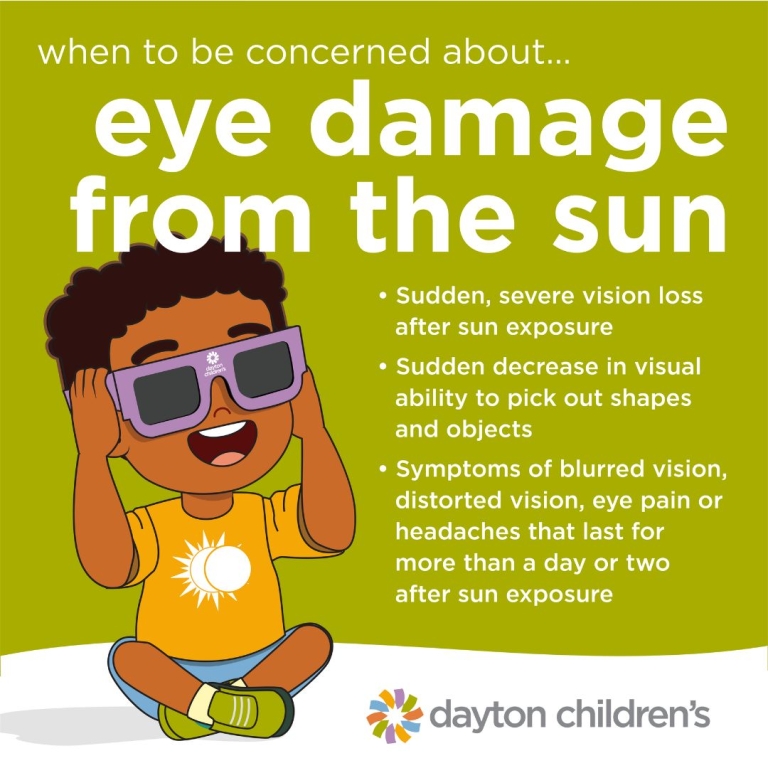3/19/24 blog post
when to be concerned about eye damage from the sun
in this article:
- What is solar retinopathy?
- How can I prevent solar retinopathy?
- What are the symptoms of solar retinopathy?
- When should I seek medical attention for my child?
Has your child ever stared at the sun for an extensive period of time? Or maybe they glanced at the solar eclipse without their protective eyewear/ solar eclipse glasses? Now you may be worried that they are going to have permanent eye damage. We want to ease your worries, so read below to understand the symptoms of eye damage from the sun and when to seek medical attention.
what is solar retinopathy?
An individual can experience eye damage from looking directly at the intense light of the sun for too long, called "photopic" injury. This can also be caused by things such as welding or laser pointers and especially during events like partial or total solar eclipses when people are likely to stare at the sun for prolonged times.
Solar retinopathy specifically affects the back of the eye known as the retina. The retina does not have pain receptors, so we do not feel the injury when it's occurring. Some individuals may only have temporary symptoms, while others may experience permanent vision loss. Damage can occur in as little as a few seconds, which is why prevention is key!
how can I prevent solar retinopathy?
There are several proactive measures you can take to prevent solar retinopathy from occurring:
- Use proper eyewear: You should never look directly at the sun without appropriate eye protection. Special solar viewing glasses or eclipse glasses are designed to block harmful ultraviolet, visible and infrared radiation. These should be placed over your regular glasses or contact lenses. Sunglasses, Polaroid filters, certain welding glasses, exposed color film, X-ray film and photographic neutral-density filters dim the brightness of the sun but do not block the damaging infrared and ultraviolet light rays.
- Pinhole projection: A pinhole projector is easy and cheap to make. The materials needed to make your own, simple pinhole projector include two sheets of paper and a pin. The pin is used to make a small hole in the center of one of the sheets of paper and the paper with the hole in it is held above the second sheet of paper without a hole in it. You look at the bottom piece of paper without the hole in it to view the sun's image. DO NOT look at the sun through the paper with the hole in it.
- Limit sun gazing and seek shade during peak sunlight hours: Avoid staring directly at the sun for extended periods, especially during solar events. During peak sunlight hours, seek shade to reduce overall sun exposure. This helps to protect your eyes and skin from harmful ultraviolet rays.
- Educate children: Teach children about the dangers of looking at the sun without protection. Supervise their activities during solar events and ensure they use appropriate solar viewing glasses.
what are the symptoms of solar retinopathy?
If any of the following symptoms occur after exposure to bright sunlight, it could be suggestive of solar retinopathy.
- Blurred vision in one or both eyes, especially centrally, known as a "Blindspot" or "Scotoma"
- Distorted vision
- Eye pain and discomfort
- Headaches
- Flashes of light or floaters
when should I seek medical attention for my child?
Seeking a professional eye examination is important if you think your child has solar retinopathy. An eye care specialist can provide a comprehensive evaluation that includes dilated eye exams and imaging tests to determine the amount of retinal damage.
- Sudden, severe vision loss after sun exposure
- Sudden decrease in visual ability to pick out shapes and objects
- Symptoms of blurred vision, distorted vision, eye pain or headaches that last more than a day or two after sun exposure
If you believe your child is experiencing eye damage from the sun, please contact your primary care provider or Dayton Children's ophthalmology at 937-641-5747.



